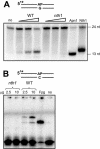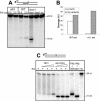A general role of the DNA glycosylase Nth1 in the abasic sites cleavage step of base excision repair in Schizosaccharomyces pombe
- PMID: 15452279
- PMCID: PMC521664
- DOI: 10.1093/nar/gkh851
A general role of the DNA glycosylase Nth1 in the abasic sites cleavage step of base excision repair in Schizosaccharomyces pombe
Abstract
One of the most frequent lesions formed in cellular DNA are abasic (apurinic/apyrimidinic, AP) sites that are both cytotoxic and mutagenic, and must be removed efficiently to maintain genetic stability. It is generally believed that the repair of AP sites is initiated by the AP endonucleases; however, an alternative pathway seems to prevail in Schizosaccharomyces pombe. A mutant lacking the DNA glycosylase/AP lyase Nth1 is very sensitive to the alkylating agent methyl methanesulfonate (MMS), suggesting a role for Nth1 in base excision repair (BER) of alkylation damage. Here, we have further evaluated the role of Nth1 and the second putative S.pombe AP endonuclease Apn2, in abasic site repair. The deletion of the apn2 open reading frame dramatically increased the sensitivity of the yeast cells to MMS, also demonstrating that the Apn2 has an important function in the BER pathway. The deletion of nth1 in the apn2 mutant strain partially relieves the MMS sensitivity of the apn2 single mutant, indicating that the Apn2 and Nth1 act in the same pathway for the repair of abasic sites. Analysis of the AP site cleavage in whole cell extracts of wild-type and mutant strains showed that the AP lyase activity of Nth1 represents the major AP site incision activity in vitro. Assays with DNA substrates containing base lesions removed by monofunctional DNA glycosylases Udg and MutY showed that Nth1 will also cleave the abasic sites formed by these enzymes and thus act downstream of these enzymes in the BER pathway. We suggest that the main function of Apn2 in BER is to remove the resulting 3'-blocking termini following AP lyase cleavage by Nth1.
Figures




Similar articles
-
Roles of base excision repair enzymes Nth1p and Apn2p from Schizosaccharomyces pombe in processing alkylation and oxidative DNA damage.DNA Repair (Amst). 2005 Nov 21;4(11):1270-80. doi: 10.1016/j.dnarep.2005.06.009. Epub 2005 Aug 1. DNA Repair (Amst). 2005. PMID: 16076563
-
AP endonuclease independent repair of abasic sites in Schizosaccharomyces pombe.Nucleic Acids Res. 2012 Mar;40(5):2000-9. doi: 10.1093/nar/gkr933. Epub 2011 Nov 13. Nucleic Acids Res. 2012. PMID: 22084197 Free PMC article.
-
Biochemical characterization and DNA repair pathway interactions of Mag1-mediated base excision repair in Schizosaccharomyces pombe.Nucleic Acids Res. 2005 Feb 18;33(3):1123-31. doi: 10.1093/nar/gki259. Print 2005. Nucleic Acids Res. 2005. PMID: 15722486 Free PMC article.
-
Abasic sites in DNA: repair and biological consequences in Saccharomyces cerevisiae.DNA Repair (Amst). 2004 Jan 5;3(1):1-12. doi: 10.1016/j.dnarep.2003.10.002. DNA Repair (Amst). 2004. PMID: 14697754 Review.
-
Oxidative DNA damage repair in mammalian cells: a new perspective.DNA Repair (Amst). 2007 Apr 1;6(4):470-80. doi: 10.1016/j.dnarep.2006.10.011. Epub 2006 Nov 20. DNA Repair (Amst). 2007. PMID: 17116430 Free PMC article. Review.
Cited by
-
The hyperthermophilic euryarchaeon Archaeoglobus fulgidus repairs uracil by single-nucleotide replacement.J Bacteriol. 2010 Nov;192(21):5755-66. doi: 10.1128/JB.00135-10. Epub 2010 May 7. J Bacteriol. 2010. PMID: 20453094 Free PMC article.
-
Tdp1 processes chromate-induced single-strand DNA breaks that collapse replication forks.PLoS Genet. 2018 Aug 27;14(8):e1007595. doi: 10.1371/journal.pgen.1007595. eCollection 2018 Aug. PLoS Genet. 2018. PMID: 30148840 Free PMC article.
-
Brc1-mediated rescue of Smc5/6 deficiency: requirement for multiple nucleases and a novel Rad18 function.Genetics. 2007 Apr;175(4):1585-95. doi: 10.1534/genetics.106.067801. Epub 2007 Feb 4. Genetics. 2007. PMID: 17277362 Free PMC article.
-
Expression and the Peculiar Enzymatic Behavior of the Trypanosoma cruzi NTH1 DNA Glycosylase.PLoS One. 2016 Jun 10;11(6):e0157270. doi: 10.1371/journal.pone.0157270. eCollection 2016. PLoS One. 2016. PMID: 27284968 Free PMC article.
-
Early Steps in the DNA Base Excision Repair Pathway of a Fission Yeast Schizosaccharomyces pombe.J Nucleic Acids. 2010 Sep 16;2010:450926. doi: 10.4061/2010/450926. J Nucleic Acids. 2010. PMID: 20936170 Free PMC article.
References
-
- Lindahl T. and Nyberg,B. (1972) Rate of depurination of native deoxyribonucleic acid. Biochemistry, 11, 3610–3618. - PubMed
-
- Memisoglu A. and Samson,L. (2000) Base excision repair in yeast and mammals. Mutat. Res., 451, 39–51. - PubMed
-
- Seeberg E., Luna,L., Morland,I., Eide,L., Johnsen,B., Larsen,E., Alseth,I., Dantzer,F., Baynton,K., Aamodt,R., Kristiansen,K.I., Rognes,T., Klungland,A. and Bjoras,M. (2000) Base removers and strand scissors: different strategies employed in base excision and strand incision at modified base residues in DNA. Cold Spring Harb. Symp. Quant. Biol., 65, 135–142. - PubMed
-
- Lindahl T. (1993) Instability and decay of the primary structure of DNA. Nature, 362, 709–715. - PubMed
Publication types
MeSH terms
Substances
LinkOut - more resources
Full Text Sources
Other Literature Sources

